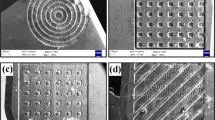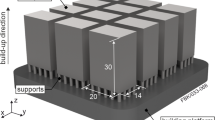Abstract
Micro grinding with a poly crystalline diamond (PCD) tool is one of the promising approaches for fabricating a micro mold on difficult-to-cut materials. As the process can also achieve good surface integrity without additional finishing processes, it could shorten total processing time and reduce total energy and resource impact. Modeling of micro grinding is necessary to understand the key design factors of the PCD tool which influence the grinding force inducing geometric errors in micromachining. This research proposes a model to describe the micro grinding of the difficult-to-cut material and predict the grinding force. The model for calculating the grinding force has been established considering contact area, grit size and distribution, tool shape, cutting depth, and cutting speed. Micromachining experiments with a PCD micro grinding tool fabricated by wire electro discharge machining have been conducted in tungsten carbide and provided the validation of the proposed model.

















Similar content being viewed by others
Abbreviations
- A c :
-
Cutting area (m2)
- A p :
-
Plowing area (m2)
- A s :
-
Contact area of the tool (m2)
- d g :
-
Grit size (m)
- d t :
-
Tool diameter (m)
- dg,max, dg,min :
-
Maximum or minimum grit size (m)
- d g,mean :
-
Mean grit size (m)
- Et, Ew :
-
Elastic modulus of the tool and workpiece (N/m2)
- F, Fn, Ft :
-
Grinding force, normal grinding force, and tangential grinding force (N)
- Fn,r, Fn,p, Fn,c :
-
Normal force in rubbing, plowing, and cutting (N)
- Ft,r, Ft,p, Ft,c :
-
Tangential force in rubbing, plowing, and cutting (N)
- hc, hp :
-
Critical cutting depth and critical plowing depth (m)
- \( h_{t}^{i} \) :
-
Uncut chip thickness of i grit at t moment (m)
- H, Hs, Hv :
-
Hardness, scratch hardness, and Vickers hardness, of the workpiece (N/m2)
- kd,t, kl,t :
-
Stiffness of the tool in lateral and depth direction (N/µm)
- kd,w, kl,w :
-
Stiffness of the workpiece in lateral and depth direction (N/µm)
- kx,m, ky,m, kz,m :
-
Stiffness of the machine tool in x-, y-, and z-axis direction (N/µm)
- kx,total, ky,total, kz,total :
-
Stiffness of the total system in x-, y-, and z-axis direction (N/µm)
- L :
-
Tool length (m)
- N :
-
The number of grits (–)
- P :
-
Static load (N)
- r i :
-
Distance of i grit from center of the tool (m)
- S :
-
Spindle speed (RPM)
- t :
-
Time (s)
- V :
-
Tool speed in grinding direction (m/s)
- Vx, Vy, Vz :
-
Tool speed in x-, y-, and z-axis direction (m/s)
- xc, yc, zc :
-
Grit center coordinate (m)
- \( x_{ran}^{i} \), \( y_{ran}^{i} \), \( z_{ran}^{i} \) :
-
Random vector of i grit (m)
- \( x_{d}^{i} , y_{d}^{i} , z_{d}^{i} \) :
-
Grit position in grinding in depth direction (m)
- \( x_{l}^{i} , y_{l}^{i} , z_{l}^{i} \) :
-
Grit position in grinding in depth direction (m)
- α :
-
Half included angle of the tip (°)
- β work :
-
The diamond grain rate of the raw PCD (%)
- δ :
-
Elastic deformation of the tool and the machine tool (m)
- σ :
-
Standard deviation of grit size (m)
- \( \upsilon_{t} , \upsilon_{w} \) :
-
Poisson’s ratio of the tool and workpiece (–)
References
Dornfeld, D., Min, S., & Takeuchi, Y. (2006). Recent advances in mechanical micromachining. CIRP Annals—Manufacturing Technology, 55(2), 745–768.
Schneider, F., Das, J., Kirsch, B., Linke, B., & Aurich, J. (2019). Sustainability in ultra precision and micro machining: A review. International Journal of Precision Engineering and Manufacturing-Green Technology, 6, 601–610.
Zhan, Z., He, N., Li, L., Shrestha, R., Liu, J., & Wang, S. (2015). Precision milling of tungsten carbide with micro PCD milling tool. The International Journal of Advanced Manufacturing Technology, 77(9–12), 2095–2103.
Liu, K., Li, X. P., & Rahman, M. (2003). Characteristics of high speed micro-cutting of tungsten carbide. Journal of Materials Processing Technology, 140(1), 352–357.
Bifano, T. G., Dow, T. A., & Scattergood, R. O. (1991). Ductile-regime grinding: A new technology for machining brittle materials. Journal of Engineering for Industry, 113(2), 184–189.
Wada, T., Masaki, T., & Davis, D. W. (2002). Development of micro grinding process using micro EDM trued diamond tools. In ASPE proceeding, annual meeting (pp. 16–19).
Morgan, C. J., Vallance, R. R., & Marsh, E. R. (2004). Micro machining glass with polycrystalline diamond tools shaped by micro electro discharge machining. Journal of Micromechanics and Microengineering, 14(12), 1687.
Morgan, C. J., Vallance, R. R., & Marsh, E. R. (2006). Micro-machining and micro-grinding with tools fabricated by micro electro-discharge machining. International Journal of Nanomanufacturing, 1(2), 242–258.
Cheng, J., & Gong, Y. D. (2013). Experimental study on ductile-regime micro-grinding character of soda-lime glass with diamond tool. The International Journal of Advanced Manufacturing Technology, 69(1–4), 147–160.
Zhan, Z., Li, L., He, N., & Shrestha, R. (2014). An experimental study on grinding parameters for manufacturing PCD micro-milling tool. The International Journal of Advanced Manufacturing Technology, 73(9–12), 1799–1806.
Kim, J., Je, T.-J., Cho, S.-H., & Whang, K.-H. (2014). Micro-cutting with diamond tool micro-patterned by femtosecond laser. International Journal of Precision Engineering and Manufacturing, 15, 1081–1085.
Mizobuchi, A., Honda, K., & Ishida, T. (2017). Improved chip discharge in drilling of glass plate using back tapered electroplated diamond tool. International Journal of Precision Engineering and Manufacturing, 18, 1197–1204.
Cao, X., Kim, B., & Chu, C. (2013). Hybrid micromachining of glass using ECDM and micro grinding. International Journal of Precision Engineering and Manufacturing, 14, 5–10.
Suzuki, H., Moriwaki, T., Yamamoto, Y., & Goto, Y. (2007). Precision cutting of aspherical ceramic molds with micro PCD milling tool. CIRP Annals, 56(1), 131–134.
Cheng, X., Nakamoto, K., Sugai, M., Matsumoto, S., Wang, Z. G., & Yamazaki, K. (2008). Development of ultra-precision machining system with unique wire EDM tool fabrication system for micro/nano-machining. CIRP Annals, 57(1), 415–420.
Nakamoto, K., Katahira, K., Ohmori, H., Yamazaki, K., & Aoyama, T. (2012). A study on the quality of micro-machined surfaces on tungsten carbide generated by PCD micro end-milling. CIRP Annals, 61(1), 567–570.
Katahira, K., Matsumoto, Y., Komotori, J., & Yamazaki, K. (2017). Experimental investigation of machinability and surface quality of sapphire machined with polycrystalline diamond micro-milling tool. The International Journal of Advanced Manufacturing Technology, 93(9–12), 4389–4398.
Malkin, S., & Cook, N. H. (1971). The wear of grinding wheels: Part 1—Attritious wear. Journal of Engineering for Industry, 93(4), 1120–1128.
Werner, G. (1978). Influence of work material on grinding forces. Annals of the CIRP, 27(1), 243–248.
Lichun, L., Jizai, F., & Peklenik, J. (1980). A study of grinding force mathematical model. CIRP Annals, 29(1), 245–249.
Tang, J., Du, J., & Chen, Y. (2009). Modeling and experimental study of grinding forces in surface grinding. Journal of Materials Processing Technology, 209(6), 2847–2854.
Durgumahanti, U. S. P., Singh, V., & Rao, P. V. (2010). A new model for grinding force prediction and analysis. International Journal of Machine Tools & Manufacture, 50(3), 231–240.
Wang, D., Ge, P., Bi, W., & Jiang, J. (2014). Grain trajectory and grain workpiece contact analyses for modeling of grinding force and energy partition. The International Journal of Advanced Manufacturing Technology, 70(9), 2111–2123.
Li, H. N., Yu, T. B., Wang, Z. X., Zhu, L. D., & Wang, W. S. (2017). Detailed modeling of cutting forces in grinding process considering variable stages of grain-workpiece micro interactions. International Journal of Mechanical Sciences, 126, 319–339.
Thanedar, A., Dongre, G., & Joshi, S. (2019). Analytical modelling of temperature in cylindrical grinding to predict grinding burns. International Journal of Precision Engineering and Manufacturing, 20, 13–25.
Nakaoku, H., Masuzawa, T., & Fujino, M. (2007). Micro-EDM of sintered diamond. Journal of Materials Processing Technology, 187–188, 274–278.
Hou, Z. B., & Komanduri, R. (2003). On the mechanics of the grinding process—Part I. Stochastic nature of the grinding process. International Journal of Machine Tools & Manufacture, 43(15), 1579–1593.
König, W., & Lortz, W. (1975). Properties of cutting edges related to chip formation in grinding. Annals of the CIRP, 24(1), 231–235.
Spedding, T. A., & Wang, Z. Q. (1997). Parametric optimization and surface characterization of wire electrical discharge machining process. Precision Engineering, 20(1), 5–15.
Younis, M. A., & Alawi, H. (1984). Probabilistic analysis of the surface grinding process. Transactions of the Canadian Society for Mechanical Engineering, 8(4), 208–213.
De Vathaire, M., Delamare, F., & Felder, E. (1981). An upper bound model of ploughing by a pyramidal indenter. Wear, 66(1), 55–64.
Williams, J. A. (1996). Analytical models of scratch hardness. Tribology International, 29(8), 675–694.
Oyen, M. L., & Cook, R. F. (2003). Load–displacement behavior during sharp indentation of viscous–elastic–plastic materials. Journal of Materials Research, 18(1), 139–150.
Yu, W., & Blanchard, J. P. (1996). An elastic–plastic indentation model and its solutions. Journal of Materials Research, 11(9), 2358–2367.
Johnson, K. L. (1987). Contact mechanics. Cambridge: Cambridge University Press.
Acknowledgements
Authors gratefully acknowledge the financial support and the donation of the ROBONANO α-0iB, one of the latest ultra-precision machine tool, to MIN LAB at UW-Madison from the FANUC Corporation, Japan.
Funding
This study was funded by FANUC Corporation.
Author information
Authors and Affiliations
Corresponding author
Ethics declarations
Conflict of interest
Dr. Sangkee Min has received research grant from FANUC Corporation. Other authors have no conflict of interest.
Additional information
Publisher's Note
Springer Nature remains neutral with regard to jurisdictional claims in published maps and institutional affiliations.
This paper was presented at PRESM2019.
Rights and permissions
About this article
Cite this article
Maeng, S., Lee, P.A., Kim, B.H. et al. An Analytical Model for Grinding Force Prediction in Ultra-Precision Machining of WC with PCD Micro Grinding Tool. Int. J. of Precis. Eng. and Manuf.-Green Tech. 7, 1031–1045 (2020). https://doi.org/10.1007/s40684-020-00199-2
Received:
Revised:
Accepted:
Published:
Issue Date:
DOI: https://doi.org/10.1007/s40684-020-00199-2




